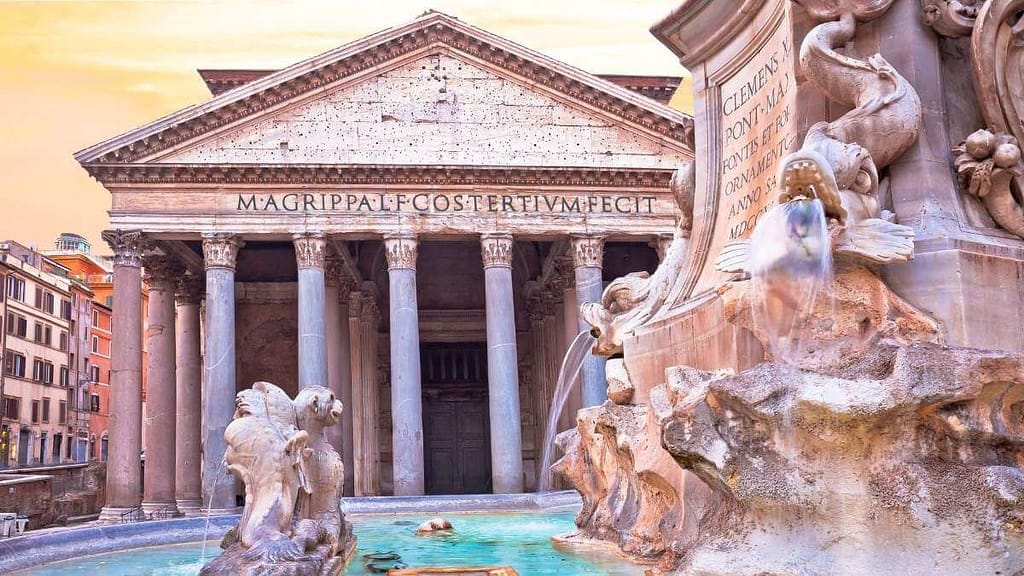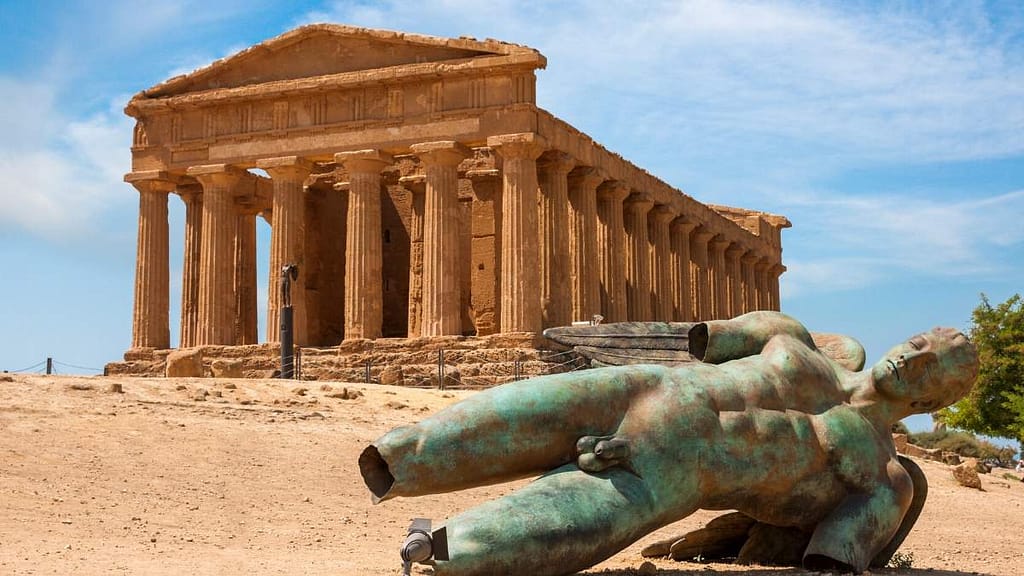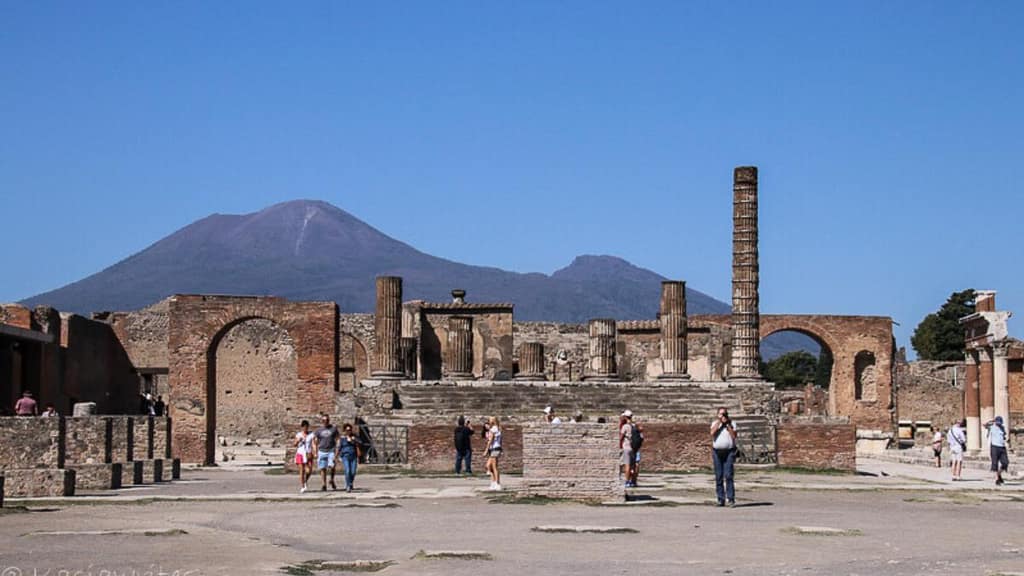Rome is home to many ancient ruins, but none are as awe-inspiring as the Pantheon. Recognized as one of the greatest architectural wonders from ancient Roman times, it has inspired many other buildings that came after it. Virtually intact for close to two millennia, there are few facts about the Pantheon in Rome that many don’t know about. After all, there are bound to be some tidbits lost to history that are not visible today.
As the lasting testimony to the genius that was Roman engineering, the Pantheon has been in continuous use since its completion in 126 A.D. Today, it is a popular destination for tourists and architecture lovers who come to Rome each year.
This post may contain compensated links. Find out more info in our DISCLAIMER.
Interesting facts about the Pantheon you might not know
What is it about the Pantheon that makes it such an important site to visit in Rome? Let’s take a look.
It is not the first Pantheon
One of the many facts about the Pantheon is that what we see today is the third incarnation of the same site. The first one, built by Marcus Agrippa in 27 B.C., burned down in 80 A.D. Emperor Domitian reconstructed it, but it too burned down in 110 A.D., after being struck by lightning.
You could say that the third time is the charm, as that’s what happened here. The third Pantheon is the one we see today and it has survived almost 2,000 years. It is generally accepted that this version of the Pantheon was completed under Emperor Hadrian sometime between 126-128 A.D. The architect Apollodorus of Damascus has been credited with the design of the Pantheon as well as serval imperial buildings erected under Emperor Trajan.
It has a puzzling dedication
The inscription above the front entrance of the Pantheon has been puzzling scholars for centuries. Inscribed in large letters are the words “M•AGRIPPA•L•F•COS•TERTIUM•FECIT.” This transcription translates to “Marcus Agrippa son of Lucius, three times consul, made this.”
It’s not clear why Hadrian decided to use Agrippa’s original inscription. However, it’s been noted that Hadrian had a practice of dedicating buildings and monuments he restored to the original dedicators. It’s not a stretch then to assume that the inscription is a nod to the original builder and the structure that was initially there.
The Pantheon is an architectural wonder
One of the essential facts about the Pantheon in Rome is that it is an architectural wonder. It consists of two main parts – the entrance based on a classical Greek presentation and the central rotunda in Roman style. It also has the largest unreinforced concrete dome in the world, which has awed people for centuries.

The entrance is decorated with 16 large monolithic columns (meaning created from single stone) made from Egyptian granite. This porch supports a gabled roof with a triangular pediment. The columns measure 11.8 m (39 feet) in height, 1.5 m (5 feet) in diameter and each weighs 60 tons. They are decorated with marble bases and Corinthian capitals (decorative tops) made from Greek marble. They were brought here from the quarries in Egypt, which wasn’t a small feat in those days.
The rotunda was built with brick and concrete with relieving arches built into the 6 metres (almost 20 feet) thick walls. The most astonishing feature of the Pantheon is its giant dome. It is the largest unsupported dome in the world, measuring 43 metres (142 feet) in diameter. That is also the same height as the dome, meaning it is a perfect sphere. It’s the mathematical design and simple geometry that wow to this day.

In the centre lies the oculus, meaning eye in Latin. This 8 metres (26 feet) wide opening distributes the weight of the dome and is the only source of light inside. The oculus isn’t’ covered, so when it rains, the water lands on the gently sloping floor, where 22 well-hidden holes help drain the water.
Also impressive are the bronze doors leading inside. The doors, measuring over 6 meters (20 feet) in height, are ancient but not original. Even so, they are still imposing.
It looked different in ancient times
The Pantheon used to look very different in ancient times than it does today. We know from the drill holes left behind that the pediment above the columns used to have an emblem decorating it. It would have been decorated with gilded bronze symbolizing Jupiter. The interior of the entrance was also panelled with marble and was decorated with reliefs. It has since been lost, revealing the brickwork.

The interior of the dome was likely gilded to look like a heavenly sphere. You can see some of the Roman bronze still in there today. On the outside, the rotunda of the Pantheon was also covered in white marble to match the entrance. Although most of the marble and bronze decorations from the Pantheon are long gone, you can catch small remnants of it today.
Much like every other Roman building, the Pantheon was pillaged of valuable metals, marble, and statues. Most of it was used in other buildings in Rome, including St. Peter’s Basilica. It’s rumoured that the canopy over the altar was made with bronze pillaged from the Pantheon.
Originally there were steps to get inside
One of the most obscure facts about the Pantheon is that it originally had steps leading up to the entrance. The building faced a rectangular colonnaded temple courtyard in Roman style. As the elevation at the time was lower than it is today, there were five marble steps leading from the square onto the entrance of the portico.

Over the years, as the buildings around crumbled, the debris eventually changed the ground level and buried the steps. Today, there is no elevation, so you walk inside on the same level as the square.
You might enjoy reading: Pantheon sinkhole reveals original ancient Roman floor
It was used as a temple and a church
While it’s not entirely clear as to the original purpose of the Pantheon, the name and design suggest that it was a pagan temple. Based on the name, Pantheon (Panthenum in Latin and Pantheion in Greek) means “Temple of All the Gods.”
It is also likely that it was a place for the emperor to make appearances and remind his subjects of his divinity, on par with the other gods. After all, Roman emperors fancied themselves as godly, so this idea isn’t a stretch. There are also sources from Roman writers like Pliny, who mentions that statues of other gods – Venus, Mars and Julius Caesar – were also at the Pantheon.
In 609 A.D., Pantheon was converted into a church dedicated to St. Mary of the Martyrs. It was one of the first pagan temples to undergo such a transformation, and this is why it still stands today. As it transitioned from a pagan temple to a Catholic church, the Pantheon avoided raids and destruction.
The most ironic of facts about the Pantheon is that while it started as a tribute to all gods, it was then dedicated to just one god. Same idea, different religion.
Enjoying facts about the Patheon? Check out the history of Italian food!
It once had bell towers
Another thing about the Pantheon most people don’t know about is that it once had two bell towers. After it was converted into a church, someone added two towers to the Pantheon’s pediment. I guess the bell towers gave it more of a traditional church appearance.

The hideous bell towers, nicknamed “asses’ ears,” have been attributed to Gian Lorenzo Bernini, an Italian sculptor and architect. Eventually, after much ridicule, the bell towers were finally removed in 1883.
It is the resting place of many illustrious people
Today the Pantheon is the resting place of prominent figures. As it became a common practice during the Renaissance, some of Italy’s most illustrious figures have been buried in the Pantheon.
Here, you’ll find the tombs of painters Raphael and Annibale Carracci, the architect Baldassare Peruzzi, the composer Arcangelo Corelli, and various poets. It is also the resting place of King Vittorio Emanuele II (the first king of unified Italy), as well as his successor Umberto I, and his wife Queen Margherita. She is the famous inspiration behind the Margherita pizza.
It influenced other architecture
If the Pantheon seems somewhat familiar to you, you’re not wrong. Many buildings in the world have taken inspiration from the design of the Pantheon. Since the revival of the arts and interest in the classics during the Renaissance, many masters, including Michelangelo and Brunelleschi, have marvelled at how the Pantheon was designed.

Both the Duomo of Florence and St. Peter’s Basilica use Pantheon as an inspiration. Other buildings that have been inspired by the Pantheon include the Pantheon in Paris, Manchester Central Library, Jefferson Memorial, Low Memorial Library, the National Gallery of Art, and the U.S. Capitol.
If you enjoy reading about the Pantheon in Rome, read facts about the Panthéon Paris
Even Piazza della Rotonda has stories to tell
It’s impossible to talk about the various facts about the Pantheon without talking about the piazza in front of it. While it’s more square than round, the piazza takes its name from the informal name of the Patheon – Church of Santa Maria Rotonda.
Over time, taverns, shops and sheds filled the original courtyard that once led the way to the Pantheon. Vendors, legal and illegal, started filling the space selling everything from fish and poultry to vegetables and birds. According to accounts of visitors from that time, the piazza was filthy, smelly and filled with dodgy characters and thieves preying on visitors. A far cry from the pretty and refined spot it is today.

The piazza underwent several modifications. Pope Eugenius IV (1431–39) had the piazza laid out and paved. The Renaissance fountain, designed by Giacomo della Porta in 1575, was commissioned by Pope Gregory XIII.
The Egyptian obelisk in the fountain, constructed by Pharaoh Ramses II, was added in 1711 under Pope Clement XI. It was part of a pair of obelisks from the Temple of Ra in Heliopolis. The other can is in Piazza della Minerva, just steps from the Pantheon. It sits on an elephant base. The obelisk located in Piazza della Rotonda was moved from Piazza San Macuto, giving it the name ‘Macuteo.’
Clement made additional modifications to the fountain, removing the original basin and adding additional flourishes. The last restoration of the fountain dates to 1880. It was during that time the square was finally cleaned up by Pope Pius VII.
Pantheon in Rome: summary
The fascination with the Pantheon started when it was completed under Hadrian. While we have a wealth of information about it today, there are still many facts about the Pantheon we don’t know about. It continues to capture our imaginations and is a lasting testament to the perseverance and genius of the ancient world.






